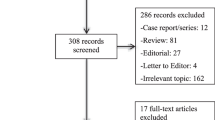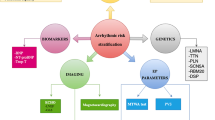Abstract
Objective
To determine the prevalence and risk factors for paroxysmal atrial fibrillation (PAF) diagnosis in non- cryptogenic ischemic stroke (CIS) patients.
Methods
In this pilot-prospective cohort study of non-CIS patients from September 2014 to September 2017, 53 patients were enrolled. 51/53 patients were implanted within 10 days of stroke onset with the Reveal LINQ insertable cardiac monitor and monitored until PAF detection or a minimum of 12 months. Inclusion required diagnosis of a non-AF stroke etiology, age ≥ 40, and either a virtual CHADS2 score ≥ 3 or ≥ 2 PAF-related comorbidities.
Results
Over a median monitoring period of 398 days, PAF was detected in 6/51 (11.8%) patients and anticoagulation was initiated in 5/6 (83.3%). Median time to PAF detection was 87 days (range 0–356 days). Median longest PAF episode was 96 min (range 1 to 1122 min), and 4/6 had multiple PAF recordings. Mean left atrial volume index was significantly higher in PAF patients (31.0 vs. 23.2 cc/m2; p = 0.04).
Conclusion
Long-term monitoring of non-CIS patients detected PAF in a clinically relevant proportion of patients, resulting in stroke prevention therapy optimization. Further study to confirm these findings and refine the subset that would benefit from long-term cardiac monitoring is warranted.

Similar content being viewed by others
References
Wolf PA, Abbott RD, Kannel WB (1991) Atrial fibrillation as an independent risk factor for stroke: the Framingham Study. Stroke 22:983–988
Jauch EC, Saver JL, Adams HP, Bruno A, Connors JJ, Demaerschalk BM, Khatri P, McMullan PW, Qureshi AI, Rosenfield K, Scott PA, Summers DR, Wang DZ, Wintermark M, Yonas H, Council AHAS (2013) Nursing CoC, disease CoPV, cardiology CoC: guidelines for the early management of patients with acute ischemic stroke: a guideline for healthcare professionals from the American Heart Association/American Stroke Association. Stroke 44:870–947
Goldstein LB, Bushnell CD, Adams RJ, Appel LJ, Braun LT, Chaturvedi S, Creager MA, Culebras A, Eckel RH, Hart RG, Hinchey JA, Howard VJ, Jauch EC, Levine SR, Meschia JF, Moore WS, Nixon JV, Pearson TA, Council AHAS (2011) Nursing CoC, Prevention CoEa, Council for High Blood Pressure Research, Council on Peripheral Vascular Disease aICoQoCaOR: guidelines for the primary prevention of stroke: a guideline for healthcare professionals from the American Heart Association/American Stroke Association. Stroke 42:517–584
Flint AC, Banki NM, Ren X, Rao VA, Go AS (2012) Detection of paroxysmal atrial fibrillation by 30-day event monitoring in cryptogenic ischemic stroke: the Stroke and Monitoring for PAF in Real Time (SMART) Registry. Stroke 43:2788–2790
Tsang TS, Petty GW, Barnes ME, O’Fallon WM, Bailey KR, Wiebers DO, Sicks JD, Christianson TJ, Seward JB, Gersh BJ (2003) The prevalence of atrial fibrillation in incident stroke cases and matched population controls in Rochester, Minnesota: changes over three decades. J Am Coll Cardiol 42:93–100
Camm AJ, Kirchhof P, Lip GY, Schotten U, Savelieva I, Ernst S, Van Gelder IC, Al-Attar N, Hindricks G, Prendergast B, Heidbuchel H, Alfieri O, Angelini A, Atar D, Colonna P, De Caterina R, De Sutter J, Goette A, Gorenek B, Heldal M, Hohloser SH, Kolh P, Le Heuzey JY, Ponikowski P, Rutten FH, Association EHR (2010) Surgery EAfC-T: guidelines for the management of atrial fibrillation: the task force for the management of atrial fibrillation of the European Society of Cardiology (ESC). Eur Heart J 31:2369–2429
Goldstein LB, Adams R, Alberts MJ, Appel LJ, Brass LM, Bushnell CD, Culebras A, DeGraba TJ, Gorelick PB, Guyton JR, Hart RG, Howard G, Kelly-Hayes M, Nixon JV, Sacco RL, Association AH, Council ASAS (2006) Primary prevention of ischemic stroke: a guideline from the American Heart Association/American Stroke Association Stroke Council: cosponsored by the Atherosclerotic Peripheral Vascular Disease Interdisciplinary Working Group; Cardiovascular Nursing Council; Clinical Cardiology Council; Nutrition, Physical Activity, and Metabolism Council; and the Quality of Care and Outcomes Research Interdisciplinary Working Group. Circulation 113:e873–e923
Toni D, Di Angelantonio E, Di Mascio MT, Vinisko R, Bath PM, Group PS (2014) Types of stroke recurrence in patients with ischemic stroke: a substudy from the PRoFESS trial. Int J Stroke 9:873–878
Strickberger SA, Ip J, Saksena S, Curry K, Bahnson TD, Ziegler PD (2005) Relationship between atrial tachyarrhythmias and symptoms. Heart Rhythm 2:125–131
Rizos T, Wagner A, Jenetzky E, Ringleb PA, Becker R, Hacke W, Veltkamp R (2011) Paroxysmal atrial fibrillation is more prevalent than persistent atrial fibrillation in acute stroke and transient ischemic attack patients. Cerebrovasc Dis 32:276–282
Hohnloser SH, Pajitnev D, Pogue J, Healey JS, Pfeffer MA, Yusuf S, Connolly SJ, Investigators AW (2007) Incidence of stroke in paroxysmal versus sustained atrial fibrillation in patients taking oral anticoagulation or combined antiplatelet therapy: an ACTIVE W Substudy. J Am Coll Cardiol 50:2156–2161
Hart RG, Pearce LA, Rothbart RM, McAnulty JH, Asinger RW, Halperin JL (2000) Stroke with intermittent atrial fibrillation: incidence and predictors during aspirin therapy. Stroke Prevention in Atrial Fibrillation Investigators. J Am Coll Cardiol 35:183–187
Kishore A, Vail A, Majid A, Dawson J, Lees KR, Tyrrell PJ, Smith CJ (2014) Detection of atrial fibrillation after ischemic stroke or transient ischemic attack: a systematic review and meta-analysis. Stroke 45:520–526
Grond M, Jauss M, Hamann G, Stark E, Veltkamp R, Nabavi D, Horn M, Weimar C, Köhrmann M, Wachter R, Rosin L, Kirchhof P (2013) Improved detection of silent atrial fibrillation using 72-h Holter ECG in patients with ischemic stroke: a prospective multicenter cohort study. Stroke 44:3357–3364
Hart RG, Diener HC, Coutts SB, Easton JD, Granger CB, O’Donnell MJ, Sacco RL, Connolly SJ, Group CSEIW (2014) Embolic strokes of undetermined source: the case for a new clinical construct. Lancet Neurol 13:429–438
Carrazco C, Golyan D, Kahen M, Black K, Libman RB, Katz JM (2018) Prevalence and risk factors for paroxysmal atrial fibrillation and flutter detection after cryptogenic ischemic stroke. J Stroke Cerebrovasc Dis 27:203–209
Sanna T, Diener HC, Passman RS, Di Lazzaro V, Bernstein RA, Morillo CA, Rymer MM, Thijs V, Rogers T, Beckers F, Lindborg K, Brachmann J, Investigators CA (2014) Cryptogenic stroke and underlying atrial fibrillation. N Engl J Med 370:2478–2486
January CT, Wann LS, Alpert JS, Calkins H, Cigarroa JE, Cleveland JC, Conti JB, Ellinor PT, Ezekowitz MD, Field ME, Murray KT, Sacco RL, Stevenson WG, Tchou PJ, Tracy CM, Yancy CW, Members AATF (2014) 2014 AHA/ACC/HRS guideline for the management of patients with atrial fibrillation: a report of the American College of Cardiology/American Heart Association Task Force on practice guidelines and the Heart Rhythm Society. Circulation 130:e199–e267
Adams HP, Bendixen BH, Kappelle LJ, Biller J, Love BB, Gordon DL, Marsh EE (1993) Classification of subtype of acute ischemic stroke. Definitions for use in a multicenter clinical trial. TOAST. Trial of Org 10172 in Acute Stroke Treatment. Stroke 24:35–41
Hindricks G, Pokushalov E, Urban L, Taborsky M, Kuck KH, Lebedev D, Rieger G, Pürerfellner H, Investigators XT (2010) Performance of a new leadless implantable cardiac monitor in detecting and quantifying atrial fibrillation: Results of the XPECT trial. Circ Arrhythm Electrophysiol 3:141–147
Heeringa J, van der Kuip DA, Hofman A, Kors JA, van Herpen G, Stricker BH, Stijnen T, Lip GY, Witteman JC (2006) Prevalence, incidence and lifetime risk of atrial fibrillation: the Rotterdam study. Eur Heart J 27:949–953
Lloyd-Jones DM, Wang TJ, Leip EP, Larson MG, Levy D, Vasan RS, D’Agostino RB, Massaro JM, Beiser A, Wolf PA, Benjamin EJ (2004) Lifetime risk for development of atrial fibrillation: the Framingham Heart Study. Circulation 110:1042–1046
Rizos T, Horstmann S, Dittgen F, Täger T, Jenetzky E, Heuschmann P, Veltkamp R (2016) Preexisting heart disease underlies newly diagnosed atrial fibrillation after acute ischemic stroke. Stroke 47:336–341
Sanfilippo AJ, Abascal VM, Sheehan M, Oertel LB, Harrigan P, Hughes RA, Weyman AE (1990) Atrial enlargement as a consequence of atrial fibrillation. A prospective echocardiographic study. Circulation 82:792–797
Go AS, Hylek EM, Phillips KA, Chang Y, Henault LE, Selby JV, Singer DE (2001) Prevalence of diagnosed atrial fibrillation in adults: national implications for rhythm management and stroke prevention: the AnTicoagulation and Risk Factors in Atrial Fibrillation (ATRIA) Study. JAMA 285:2370–2375
Pathak RK, Elliott A, Middeldorp ME, Meredith M, Mehta AB, Mahajan R, Hendriks JM, Twomey D, Kalman JM, Abhayaratna WP, Lau DH, Sanders P (2015) Impact of CARDIOrespiratory FITness on arrhythmia recurrence in obese individuals with atrial fibrillation: the CARDIO-FIT Study. J Am Coll Cardiol 66:985–996
Magnani JW, Hylek EM, Apovian CM (2013) Obesity begets atrial fibrillation: a contemporary summary. Circulation 128:401–405
Favilla CG, Ingala E, Jara J, Fessler E, Cucchiara B, Messé SR, Mullen MT, Prasad A, Siegler J, Hutchinson MD, Kasner SE (2015) Predictors of finding occult atrial fibrillation after cryptogenic stroke. Stroke 46:1210–1215
Scheitz JF, Erdur H, Haeusler KG, Audebert HJ, Roser M, Laufs U, Endres M, Nolte CH (2015) Insular cortex lesions, cardiac troponin, and detection of previously unknown atrial fibrillation in acute ischemic stroke: insights from the troponin elevation in acute ischemic stroke study. Stroke 46:1196–1201
Bernstein RA, Kamel H, Granger CB, Kowal RC, Ziegler PD, Schwamm LH (2017) Stroke of known cause and underlying atrial fibrillation (STROKE-AF) randomized trial: design and rationale. Am Heart J 190:19–24
Acknowledgements
We thank Connie Lau, Ruthanne Carey, and Christina M. Kelly for help in protocol execution and data management.
Funding
Partial funding for this study was provided by Medtronic, Inc.
Author information
Authors and Affiliations
Corresponding author
Ethics declarations
Conflicts of interest
The authors declare that they have no conflict of interest.
Ethical standards
The local Institutional Review Board (Northwell IRB) approved the study protocol, all study procedures were performed in accordance with the 1964 Declaration of Helsinki ethical standards, and all participants signed written informed consent prior to study activities.
Rights and permissions
About this article
Cite this article
Katz, J.M., Eng, M.S., Carrazco, C. et al. Occult paroxysmal atrial fibrillation in non-cryptogenic ischemic stroke. J Neurol 265, 2237–2242 (2018). https://doi.org/10.1007/s00415-018-8982-9
Received:
Revised:
Accepted:
Published:
Issue Date:
DOI: https://doi.org/10.1007/s00415-018-8982-9




